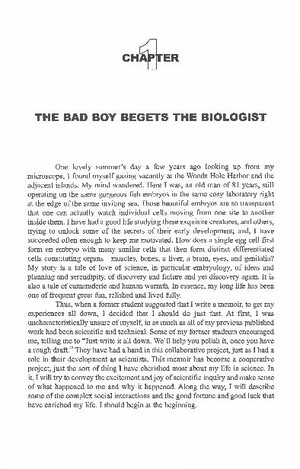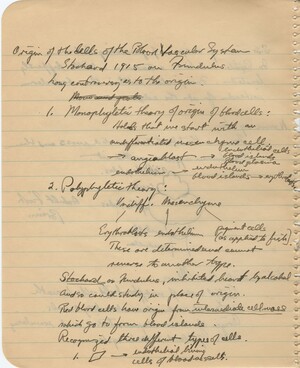MBL Courses
Title page, copyright information, and dedication for John P. Trinkaus' autobiography, "Embryologist"
Notes from William Ballard's lecture. Trinkaus begins notes on "Coelenterate embryology" with information on "Medusa form"
The autobiography of developmental biologist John Philip Trinkaus
Notes from Hubert Goodrich's lecture. Trinkaus continues his diagrams on the 'Development of the Circulatory System of Teleost' from page 25 and 26 with stages XIII and XIV and descriptions of stages VIII through XIV
Chapter 1 of John P. Trinkaus' autobiography, "Embryologist"
Chapter 2 of John P. Trinkaus' autobiography, "Embryologist"
Notes from Hubert Goodrich's lecture. Trinkaus makes notes on the 'Origin of the Cells of the Blood Vascular System', including the 'Monophyletic theory of origin of blood cells' and 'Polyphyletic theory', with special reference to Stockard on Fundulus. Stockard recognized three different types of cells (with diagram): '1. endothelial living cells of blood vessels'
Notes from Hubert Goodrich's lecture. Trinkaus takes notes on the 'Origin of Germ Cells'. '1. Theory of early differentiation of germ cells' with historical notes and a diagram
Notes from Hubert Goodrich's lecture. Trinkaus continues his notes on the three different types of cells (with diagrams) from page 20: '2. amaeboid-red blood cells' and '3. mereamaeboid-chromatophores'. Trinkaus also takes notes on 'Stockard's Idea of Blood Channels' and 'Armstrong-rhythm of heart beat in Fundulus'
Notes from Hubert Goodrich's lecture. Trinkaus continues his notes on the origin of germ cells from page 22 and begins a new section on 'Hybridization'
Notes from Hubert Goodrich's lecture. Trinkaus continues his notes on Hybridization from page 23 with a section titled 'Effect on Individual Cells'. Trinkauscreates a chart comparing Fundulus heteroclitus and Fundulus majalis
Notes from Hubert Goodrich's lecture. Trinkaus continues his diagrams on the 'Development of the Circulatory System of Teleost' from page 25 with stages IX-XII and descriptions of stages I through VII












